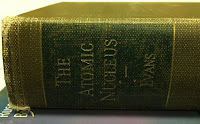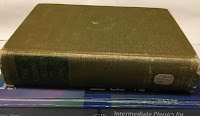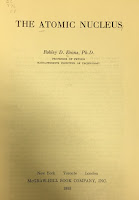 |
| The Atomic Nucleus, by Robley Dunglison Evans. |
Evans was born in University Place, Nebraska in 1907. When he was five his family moved to California. He won a scholarship to the California Institute of Technology, where he studied math and science, and earned spending money playing drums in a jazz band. He considered majoring in the history of science, but ultimately decided to focus on physics. He remained at Caltech for graduate school analyzing cosmic rays. Nobel Prize winner Robert Millikan was his thesis advisor.
I enjoyed his reminiscences about 1932, that famous year in nuclear physics when the deuteron, positron, and neutron were all discovered. Carl Anderson, who first detected the positron, was at Caltech photographing cosmic ray particles using a cloud chamber. Evans recalls when
...in one of these pictures, he [Anderson] got a track … [that] looked like an electron, but it was bent the wrong way [by the magnetic field] and had too long a range, too long a path length to possibly be the only positive particle we knew about, the proton. I remember seeing Carl in the morning coming dashing out of the darkroom, and I guess I was the first one he ran into in the hall, and he said, “My God, Bob, look at this. This thing is going the wrong way. And I checked the film in my camera. I didn’t have the emulsion facing the wrong way; I had it the right way. Everything looks all right here, and I can’t imagine what possibly is wrong, but maybe [it’s] that damn Pinky Klein,” who was a practical joker with a well-established reputation … So Carl suggested that maybe Pinky had reversed the magnetic field on him just to play a joke…Of course it wasn’t Pinky. Anderson won the Nobel Prize for his discovery of the positron, a positive electron.
Nowadays physics grad students often complain about their job prospects, and rightly so. But the situation was worse in 1932 during the depths of the Great Depression. Evans says “I remember that some of them [the grad students] like Jack Workman who was there urged several of us to join together to go to the state of Washington and grow apples, and we fresh new PhD’s in physics were to become apple farmers. It was that bad.”
But not that bad for Evans himself. After graduating, he started a post doc at Berkeley. In 1934, he accepted a job on the faculty at MIT, where he taught the first class in the United States about nuclear physics. The Atomic Nucleus grew out of this class. He started writing the book by creating a giant card file, with the abstract of every nuclear physics research article written out, one per card.
He became interested in the medical applications of nuclear physics after hearing about watch dial painters who swallowed radium paint and got cancer. (The recently published book The Radium Girls by Kate Moore tells the story; it's on my list of books to read this summer.) Also, at that time people like Eben Byers were drinking radium water as a tonic. Evans claimed “We know of one physician in Chicago, for example, who injected more than a thousand patients, the normal regime being 10 microcuries intravenously once a week for a year! That’s 500 microcuries or half a millicurie.”
Evans become an expert in the new field of nuclear medicine. Based on his studies, he estimated the largest permissible load of radioactivity for a person was 0.1 microcurie. This value was something of a rough guess, but has held up well over time.
I was surprised that during World War II Evans was not at Los Alamos helping to build the atomic bomb. He did, however, carry out war work. For instance, he was responsible for measuring radioactivity in the Belgian uranium ores brought from the Congo for the Manhattan Project. He also invented a scheme to mark land mines with the radioactive isotope cobalt-60, so if American troops had to retake ground previously mined, they could easily detect and remove the mines. Finally, he created a technique to monitor the preservation of blood using radioactive iron as a tracer.
Evans developed a method to use radioactive iodine to diagnose and treat goiter. He taught at MIT until his retirement in 1972. As a student, IPMB author Russ Hobbie took a class with Evans in statistical nuclear physics, based on Chapters 26-28 in The Atomic Nucleus.
Evans won many awards throughout his career, including the Enrico Fermi Award for pioneering work “in measurements of body burdens of radioactivity and their affects on human health, and in the use of radioactive isotopes for medical purposes.” Robley Evans died in 1996, at age 88. You can read his obituary here and here.
The Atomic Nucleus was a leading nuclear physics textbook of its day, and according to Google Scholar it has been cited nearly 4000 times. If interested in reading The Atomic Nucleus, you can download it free online at https://archive.org/details/TheAtomicNucleus.
You never know what tales lie buried beneath each word of IPMB.






No comments:
Post a Comment